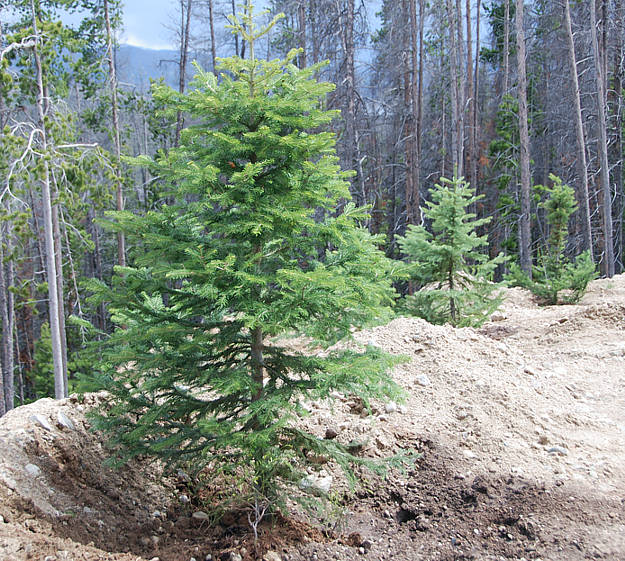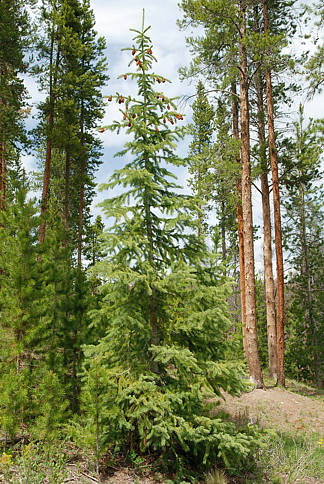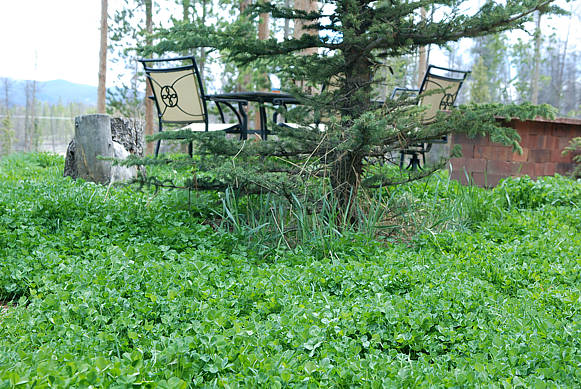Grand County Landscaping and Alpine Gardeners' Guide
 Grand County is almost surrounded by
Grand County is almost surrounded by
National Forests. Over a period of 30 years, we have gained some experience in
successfully and legally moving alpine fir trees and englelman spruce a short distance
from the nearby National Forest to homes in the Grand Lake area. The trees in the
photo directly below, even the big ones to the right, were moved when they were
three to four feet tall to our Honeymoon Cabin.

Scroll down for many more photos and tips. The place to go for permits to transplant trees
is the National Forest Service "building" between Granby and SilverCreek (west side of
Highway 40, south of Power World). While you are there, you can also renew your annual
permits for National Recreation Area boat launches, Rocky Mountain National Park and
also Colorado State Parks. For the Recreation Area, one permit can cover parking for several
vehicles in the same family's name, and also snowmobile use along the lakes (please be
aware that there is open water in places, even in January; do not go out on the lakes without
good information as to where it is very safe). At the Forest Service building you can browse
through a wealth of information that is free and some which can be purchased that can help
you get the most out of the National Treasury of land holdings that is the reason why people
come to Grand Lake and buy homes and land. There is also some information on excellent
areas just beyond Grand County, for example, the Eagles Nest Wilderness. Scroll down
for details on transplanting trees.

A basic permit is $10 per tree. You'll have to dig up the trees by hand. Anything
more than 5 feet tall is going to be too difficult. Your chances of success will be
higher with a 3 foot tall tree. Use a tree spade. Use a shovel with a long steel cutting
edge that will let you get under the tree's root system. You can use other shovels for
leverage.Dig as deep as you can and all around. Do not force the tree out of the ground.
Lift the uprooted tree and its roots onto a tarp, plastic or better, damp burlap.
Hopefully, you'll have its new home already prepared so that within an hour or
two, you can have tree in its new location. The best time of the year to do this is
at the beginning of the growing season (late May or early June) or at the end of the
growing season. For the year 2009, mid-June should be fine since the weather
has been cooler and wetter than normal. Scroll down for more photos and tips.

You cannot use machinery to dig up trees in the National Forest. If by chance, you do have
machinery available at their new location (or you planned ahead a year or two!), then dig
up a full cubic yard for each tree's location. You will then refill most of this hole before
adding the tree and you'll refill it without the rocks you found and you'll add additional mulch,
nutrients and/or top soil to ensure that once your tree has grown to about 8 feet, it will be ready
to take off and grow another 20 feet in the next five to ten years. Long ago when I was in high
school and junior high, my school had a special detention policy for miscreants. For each
infraction, one had to dig a cubic meter hole and then fill it and mark it with a small tree
sapling on top. Needless to say, the school now has a beautiful campus. Top soil is a rare
commodity in Grand County. For small projects, we recommend you visit the Cold Springs
greenhouse east of Granby. Cold Springs also has a lovely plant store in Grand Lake this summer,
on the north side of main street just before the Boardwalk starts (near the Terrace Inn Restaurant).
For tree transplants, they recommend that you use a generous amount of the Forest Magic mulch
that they sell in bags. Scroll down for more views.



After you have dug up the yard to plant trees, you can quickly beautify the area around
the tree(s) by planting fast growing and hardy Dutch Clover. More on that very soon.
If you plan on doing trees this summer, you need to get your permits and trees
right away before the growing season gets any further along.
Colorado water law does not give home owners the automatic right to water lawns.
or even to fill an outdoor hot tub. During the initial transplanting recovery stage you
have to keep the roots wet. The intelligent thing to do is to create a rainfall and
snowmelt catch basin around each tree so that after a year, no additional water
will be needed. The same goes for existing trees. However, if we hit a period
of drought, then additional watering is a must. A mix of mulch, clay and maybe
some additional nutrients can go a long ways towards reducing the amount of
watering that has to be done to protect your initial investment.
If you want to see incredible natural lawns and alpine gardens, hike to timberline!
Happy Trails!
 .. to top of page .. or .. Grand County Scenery .. or .. jump to Main Menu ..
.. to top of page .. or .. Grand County Scenery .. or .. jump to Main Menu ..
 .. to Archived Scenery page .. to Real Estate choices .. to splash page: www.MountainLake.com ..
.. to Archived Scenery page .. to Real Estate choices .. to splash page: www.MountainLake.com ..
© Text & Structure of this site is Copyrighted 5/1/96.
 Grand County is almost surrounded by
Grand County is almost surrounded by 




